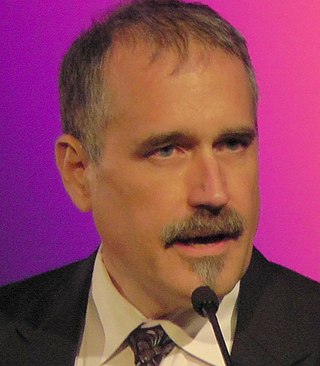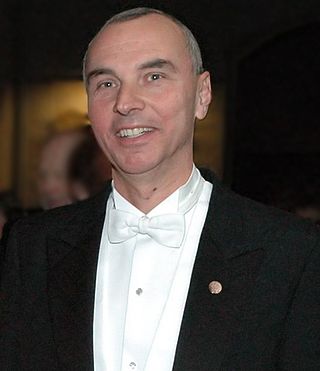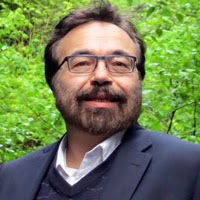Related Research Articles
John G. McWhirter FRS FREng FIMA FInstP FIEE FLSW is a British mathematician and engineer in the field of signal processing.

Thomas Wiegand is a German electrical engineer who substantially contributed to the creation of the H.264/AVC, H.265/HEVC, and H.266/VVC video coding standards. For H.264/AVC, Wiegand was one of the chairmen of the Joint Video Team (JVT) standardization committee that created the standard and was the chief editor of the standard itself. He was also a very active technical contributor to the H.264/AVC, H.265/HEVC, and H.266/VVC video coding standards. Wiegand also holds a chairmanship position in the ITU-T VCEG of ITU-T Study Group 16 and previously in ISO/IEC MPEG standardization organizations. In July 2006, video coding work of the ITU-T was jointly led by Gary J. Sullivan and Wiegand for the preceding six years. It was voted as the most influential area of the standardization work of the CCITT and ITU-T in their 50-year history. Since 2018, Wiegand has served as chair of the ITU/WHO Focus Group on Artificial Intelligence for Health (FG-AI4H). Since 2014, Thomson Reuters named Wiegand in their list of “The World’s Most Influential Scientific Minds” as one of the most cited researchers in his field.

Martin Vetterli was president of École polytechnique fédérale de Lausanne (EPFL) in Switzerland, succeeding Patrick Aebischer. He's a professor of engineering and was formerly the president of the National Research Council of the Swiss National Science Foundation.

Alan Conrad Bovik is an American engineer, vision scientist, and educator. He is a professor at the University of Texas at Austin (UT-Austin), where he holds the Cockrell Family Regents Endowed Chair in the Cockrell School of Engineering and is Director of the Laboratory for Image and Video Engineering (LIVE). He is a faculty member in the UT-Austin Department of Electrical and Computer Engineering, the Machine Learning Laboratory, the Institute for Neuroscience, and the Wireless Networking and Communications Group.

Peter (Petre) Stoica is a researcher and educator in the field of signal processing and its applications to radar/sonar, communications and bio-medicine. He is a professor of Signals and Systems Modeling at Uppsala University in Sweden, and a Member of the Royal Swedish Academy of Engineering Sciences, the United States National Academy of Engineering (International Member), the Romanian Academy, the European Academy of Sciences, and the Royal Society of Sciences. He is also a Fellow of IEEE, EURASIP, IETI, and the Royal Statistical Society.

Georgios B. Giannakis is a Greek-American Computer Scientist, engineer and inventor. He has been an Endowed Chair Professor of Wireless Telecommunications, he was Director of the Digital Technology Center, and at present he is a McKnight Presidential Chair with the Department of Electrical and Computer Engineering at the University of Minnesota.
Anthony George Constantinides FREng FIET is a professor of signal processing and the founder of the Communications and Signal Processing Group of the Department of Electrical and Electronic Engineering in Imperial College London. He has been actively involved with research in various aspects of digital filter design, digital signal processing, and communications for more than 40 years. Professor Constantinides' research spans a wide range of digital signal processing and communications, both from the theoretical as well as the practical points of view. His recent work has been directed toward the demanding problems arising in Financial signal processing and he now leads the Financial Signal Processing Lab in the EEE department of Imperial College London.

Murat Kunt is a Swiss scientist of Turkish origin. He is known for his research and teaching in the general area of digital signal processing and image and video processing in particular. He is the author of more than 240 publications, 15 books and 16 patents. He played a pioneering role in digital image and video compression. Among the 75 doctoral students he supervised, 20 are now university professors.

Robert W. Heath Jr. is an American electrical engineer, researcher, educator, wireless technology expert, and a Professor in the Department of Electrical and Computer Engineering at the University of California, San Diego. He is also the president and CEO of MIMO Wireless Inc. He was the founding director of the Situation Aware Vehicular Engineering Systems initiative.

AlfonsoFarinaFREng is an Italian electronic engineer and former industry manager. He is most noted for the development of the track while scan techniques for radars and generally for the development of a wide range of signal processing techniques used for sensors where tracking plays an essential role. He is author of about 1000 publications. His work was aimed to a synergistic cooperation between industry and academy.
Mérouane Debbah is a researcher, educator and technology entrepreneur. Over his career, he has founded several public and industrial research centers, start-ups and held executive positions in leading ICT companies. He is now professor at Khalifa University in Abu Dhabi, United Arab Emirates and founding director of the Khalifa University 6G Research Center. He is a frequent keynote speaker at international events in the field of telecommunication and AI. His research has been lying at the interface of fundamental mathematics, algorithms, statistics, information and communication sciences with a special focus on random matrix theory and learning algorithms. In the communication field, he has been at the heart of the development of small cells (4G), massive MIMO (5G) and large intelligent surfaces (6G) technologies. In the AI field, he is known for his work on large language models, distributed AI systems for networks and semantic communications. He received multiple prestigious distinctions, prizes and best-paper awards for his contributions to both fields and according to research.com is ranked as the best scientist in France in the field of electronics and electrical engineering.

Shrikanth Narayanan is an Indian-American Professor at the University of Southern California. He is an interdisciplinary engineer–scientist with a focus on human-centered signal processing and machine intelligence with speech and spoken language processing at its core. A prolific award-winning researcher, educator, and inventor, with hundreds of publications and a number of acclaimed patents to his credit, he has pioneered several research areas including in computational speech science, speech and human language technologies, audio, music and multimedia engineering, human sensing and imaging technologies, emotions research and affective computing, behavioral signal processing, and computational media intelligence. His technical contributions cover a range of applications including in defense, security, health, education, media, and the arts. His contributions continue to impact numerous domains including in human health, national defense/intelligence, and the media arts including in using technologies that facilitate awareness and support of diversity and inclusion. His award-winning patents have contributed to the proliferation of speech technologies on the cloud and on mobile devices and in enabling novel emotion-aware artificial intelligence technologies.
Björn Ottersten is a Swedish educator, researcher, and electrical engineer who is the co-inventor of Space/Spatial Division Multiple Access (SDMA) technology. He has made contributions in array signal processing and wireless communications and has received many notable awards in these areas. Currently, he is a Professor of Signal Processing at Royal Institute of Technology (KTH), Stockholm, Sweden, and the founding director of the Interdisciplinary Centre for Security, Reliability and Trust, at University of Luxembourg, Luxembourg.

Sergio Barbarossa is an Italian professor, engineer and inventor. He is a professor at Sapienza University of Rome, Italy.

Mads Græsbøll Christensen is a Danish Professor in Audio Processing at Department of Architecture, Design & Media Technology, Aalborg University, where he is also head and founder of the Audio Analysis Lab which conducts research in audio and acoustic signal processing. Before that he worked at the Department of Electronic Systems at Aalborg University and has held visiting positions at Philips Research Labs, ENST, UCSB, and Columbia University. He has published extensively on these topics in books, scientific journals and conference proceedings, and he has given tutorials and keynote talks at major international scientific conferences.
Jelena Kovačević is a Serbian American engineering professor, whose research has focused on signal processing and data science. She was named the first female dean of the New York University Tandon School of Engineering at New York University (NYU) in August 2018. In May 2023, she announced she will be stepping down effective August 2024.

Moeness G. Amin is an Egyptian-American professor and engineer. Amin is the director of the Center for Advanced Communications and a professor in the Department of Electrical and Computer Engineering at Villanova University.

Yonina C. Eldar is an Israeli professor of electrical engineering at the Weizmann Institute of Science, known for her pioneering work on sub-Nyquist sampling.

Michael Unser (born April 9, 1958 in Zug, Switzerland) is a Swiss engineer and a professor at the École Polytechnique Fédérale de Lausanne (EPFL). His research focuses on the field of biomedical image processing.
Ramalingam "Rama" Chellappa is a Bloomberg Distinguished Professor, who works at Johns Hopkins University. At Johns Hopkins University, he is a member of the Center for Language and Speech Processing, the Center for Imaging Science, the Institute for Assured Autonomy, and the Mathematical Institute for Data Sciences. He joined Johns Hopkins University after 29 years at The University of Maryland. Before that, he was an assistant, associate professor, and later, director, of the University of Southern California's Signal and Image Processing institute.
References
- ↑ "Technical Area Committees – EURASIP". eurasip.org. Retrieved 2024-05-29.
- ↑ "Society Awards – EURASIP". eurasip.org. Retrieved 2024-05-29.